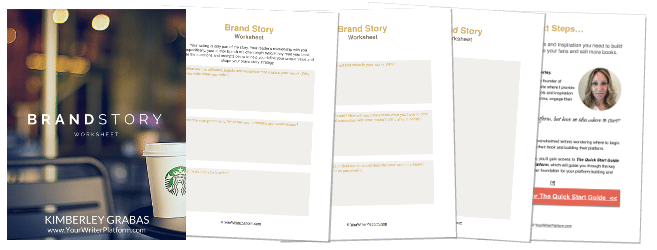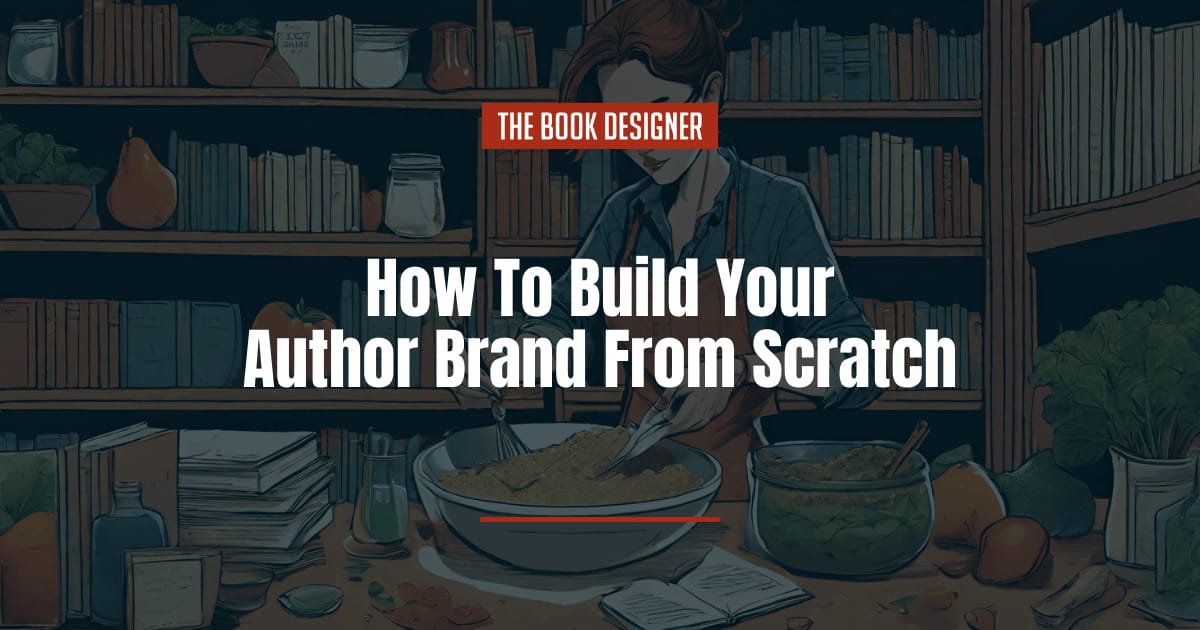You might be wondering if having an author brand actually matters or if you should only focus on improving your writing.
The answer? These days it’s not enough just to be good at what you write. You need to be able to create an emotional connection with your reader – often before they’ve had a chance to read your book. The goal of creating an author brand is to intentionally craft that emotional connection with your readers.
How you position your work, how you distinguish yourself from others in your field or genre, and how you communicate to your audience can be the difference between a brand that attracts and retains viewers and one that falls flat.
It’s a bit naive to think you can win any acclaim as an author while avoiding having an author brand.
Effective branding is foundational to the development of your writer platform and audience-building efforts. The author who can tap into what their readers yearn for – and construct an entire experience around what they crave – is the author that earns the devoted fan base.
Your author brand should be intentional
We are always being judged, assessed and evaluated by others. People will interpret your work, your relevance and the value you offer by what you intentionally – and unintentionally – share.
As your sphere of influence and visibility increases, so does the number of people who have the opportunity to form an impression about you.
It’s unavoidable.
Successful authors shape and manage readers’ perceptions by controlling the message. That’s why a powerful author brand is designed – not stumbled upon by accident. You must envelop readers in an experience, from the moment they come in contact with you, to after they buy, and beyond.
What is an author brand?
Whether you’re actively building your personal brand or not, it’s happening. So, why not be deliberate in shaping the direction it takes?
‘Author brand’ isn’t corporate-speak for “society’s attempt to force me to label (and limit) my creative genius.”
Everything factors into your brand, from your social media updates to your blog posts and your podcast interviews. Your author collaborations and your newest releases fit into what your brand is. Everything adds to the bigger picture of who you are, and what you can bring to the table.
Your author brand is an ongoing, continually evolving story that communicates what makes your work unique. It represents an implied promise to your readers of what they can expect you to consitently deliver.
Your brand doesn’t have to feel cheesy, packaged or restrictive. In fact, if you’re purposeful in your brand planning from the beginning – even before you publish your first book – you can frame yourself and your work in a way that is satisfying to both you and your future readership.
When readers have a multitude of other options vying for their limited attention, your author brand answers the question, “Why you?”
If you can elicit an emotional reaction in a reader, and emphasize what makes your work unique, not only will you stand out from the crowd and gain recognition from readers, you will earn their loyalty and trust as well.
Your “brand story” (and how well you tell it) determines the strength of your brand – the impact of which is measured by the ardor and devotion of your fans and supporters.

A strong author brand is a credible signal of quality to book buyers, which means more authority, more influence, and even premium pricing. As you increase the perceived value of your personal brand, your brand equity rises.
Build your author brand so it makes a dent in the universe
The concept of branding, however, isn’t what most writers have a problem with. It’s the application that causes people to struggle. How do you actually build an author brand?
With the expansive growth of social media, and tech advances that help multiply reach and increase access, even the smallest of businesses, with the smallest of budgets (authors included) are able to grab and hold the attention of their target audiences in a very impactful way – through brand storytelling.
And guess who’s uniquely qualified to capitalize on this strategic marketing opportunity?
“Marketers have been telling brand stories for years through advertising, in-person brand experiences, and so on, but the art of writing those brand stories as effective pieces of online content is a challenge that few are trained to do. That’s because the best brand storytellers understand the critical elements of fiction writing, which are skills that few marketers have been formally trained to do.”
Well that’s convenient. Might you possess just such skills?
Then with the right mix of branding fundamentals (which we’ll explore below), and an intriguing, emotional and well-crafted brand story, you can expertly build a memorable and meaningful author brand.
Start with the branding fundamentals
When it comes to building a compelling author brand, there are two main areas that require your focus: brand identity and brand awareness.
There is no point in marketing and promoting a brand you have yet to crystallize, so your first step is to very clearly define your brand identity and purpose. Only once you have this nailed down can you confidently promote – and have your readers champion – your brand.
Brand identity and purpose
This is where you pull together the visual, written and in-person brand elements that support (or tie in with) your brand story, the needs and desires of your readers, and your personal objectives for your writing career.
Again, it’s not just what you say, but how you communicate your message to your audience that makes an impact.
It’s also important to note here, that there is a difference between brand and genre. Be careful not to over-invest in the stylings and look of one particular genre, unless you’re certain that it “fits” with your brand strategy and story longer term.
(If you already have an established author brand, use the following to revisit, review, and refine what you already have in place. Brands are not static, so an audit of your current brand strategy is a good way to ensure you’re still on track.)
Brand identity checklist:
- Main logo – graphic or font based.
- Brand colours – choose two to three main colours (get the hex codes so you can use your exact brand colours when designing your own graphics).
- Brand fonts – one main or body font and one accent font.
- Brand style elements – patterns, icons, graphics or other style elements.
- Brand tagline – your highly concise mission statement.
- Website/blog – functions as your author headquarters. Does your about page, contact page, book/sales page, blog categories, navigation menu, blog posts and website design all convey a consistent (and accurate) brand message?
- Social media accounts with on-brand design – same or similar handles/URL’s and consistent platform profile photo and description.
- Social media graphics and image templates – Facebook and Twitter covers; logo/URL watermark (to add to all shared images).
- Professional headshot and additional photos – consistent across all social media profiles, and for use on your about page and within your media kit (or press page).
- Business cards and other printed marketing materials – old school, but still effective.
- Blog post image templates – compelling (quality) images that reflect a cohesive brand style.
- Other visuals – book covers, photography, illustrations, screenshots, quote graphics, book artwork and video.
- Email – email newsletter template or other email graphics.
- Domain name and professional email account – purchase your domain name for your site and set up an email that attaches to it.
Brand awareness plan
Once you have your brand story and other brand elements defined, the next step is developing a plan to promote and solidify your brand in the eyes of readers.
- How will you demonstrate the feelings, values and unique qualities that you want attributed to you and your writing?
- How will you grab your reader’s attention or pique their interest?
- Who needs to know about your books? Which types of people would be most interested in your writing? (And where can they be found?)
- What are other authors doing in your genre or niche? What are their competencies and how can you position yourself and your work differently?
There are three aspects to creating more awareness for your author brand:
1. Goals and Objectives
Identify your goals and objectives. Everything you write or create should be moving you closer to these goals. You need to know where you are trying to take your readers (the buyers journey), and create goals and objectives for your content that will move people to action.
As you start to promote and grow your brand, make sure you know what your end goals are.
2. Promotion Strategy
One of your main goals to build your author brand is to not just have the brand, but you need to reach others. You will need the following brand promotion essentials:
- Content strategy – your publishing plan of action for your books, blog, social media, audio, video and email list). Capitalize on each platform’s strengths to share different aspects of your brand story.
- Brand style guide – create a brand style guide that includes your brand specific fonts, colours, brand elements, patterns and imagery style, so that all your marketing materials are consistent and at your finger tips.
- Ideal reader persona – by drafting a detailed reader persona, you establish a framework and a way to focus your efforts for reaching and connecting with your “people” – those who’ll benefit most from your work.
- Digital media kit – a marketing package for your book that makes it dead simple for the media and others to feature you and your work.
- Lead magnet – a “can’t-say-no” email opt-in incentive that builds your list.
- Street team – word-of-mouth is the best form of promotion there is, so nurture your growing legion of raving fans and supporters with extra perks and benefits.
- Collaboration – build your network and join forces with other authors and industry influencers.
3. Growth
As your brand evolves, you’ll need to gauge your audience’s interest and ask for their input and feedback along the way. Continue to build brand equity by continuously re-evaluating, refining and growing your brand reputation.
You can also consider additional markets and audiences you can tap into, additional platforms you can develop, or additional books or series you can write.
Even sub-brands – that target multiple genres and different pockets of readers with distinct colours, types of imagery, logos, different promises, and different positioning – are a possibility as you continue to grow your author brand over time.Just note that before adopting sub-brands, you need to ensure your offerings are not in conflict (writing erotica and children’s books, for example).
You’ll also need to decide if you can afford the creative and time costs required to build and maintain each sub-brand.
What will it really mean to build a powerful author brand?
A well-defined author brand acts as a guidepost by which you position and gauge all your activities, objectives and goals. And, from your readers’ perspective, your author brand accentuates the experience of your writing and creates a memorable encounter that – ideally –they’ll seek out again and again.
If done right, a powerful brand will build your reputation as an author and assure your marketing success.
What are your thoughts on building a personal or author brand? How necessary do you feel it is to the success of your writing career?
Need more help crafting your author brand?
We have a few great resources for you!
Read through this great article Author Branding: How to Build and Maintain Your Unique Brand.
Interested in using social media to build your author brand? Here is a resource for you! Social Media for Writers and Authors: Full Tutorial Guides


